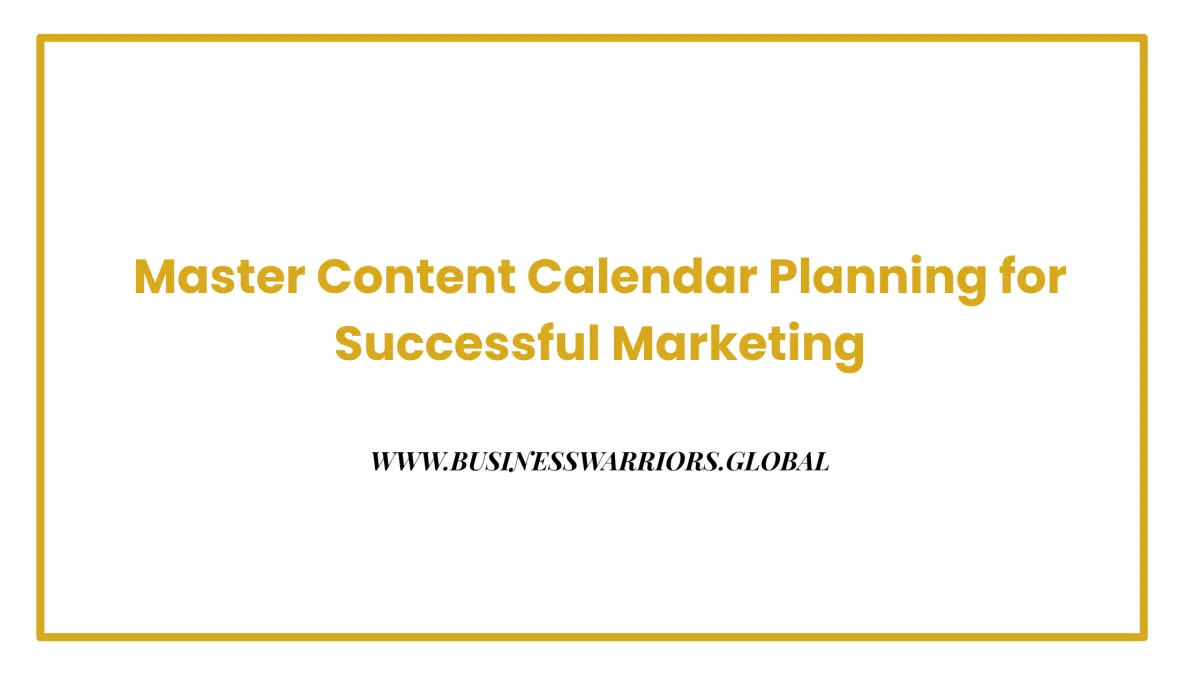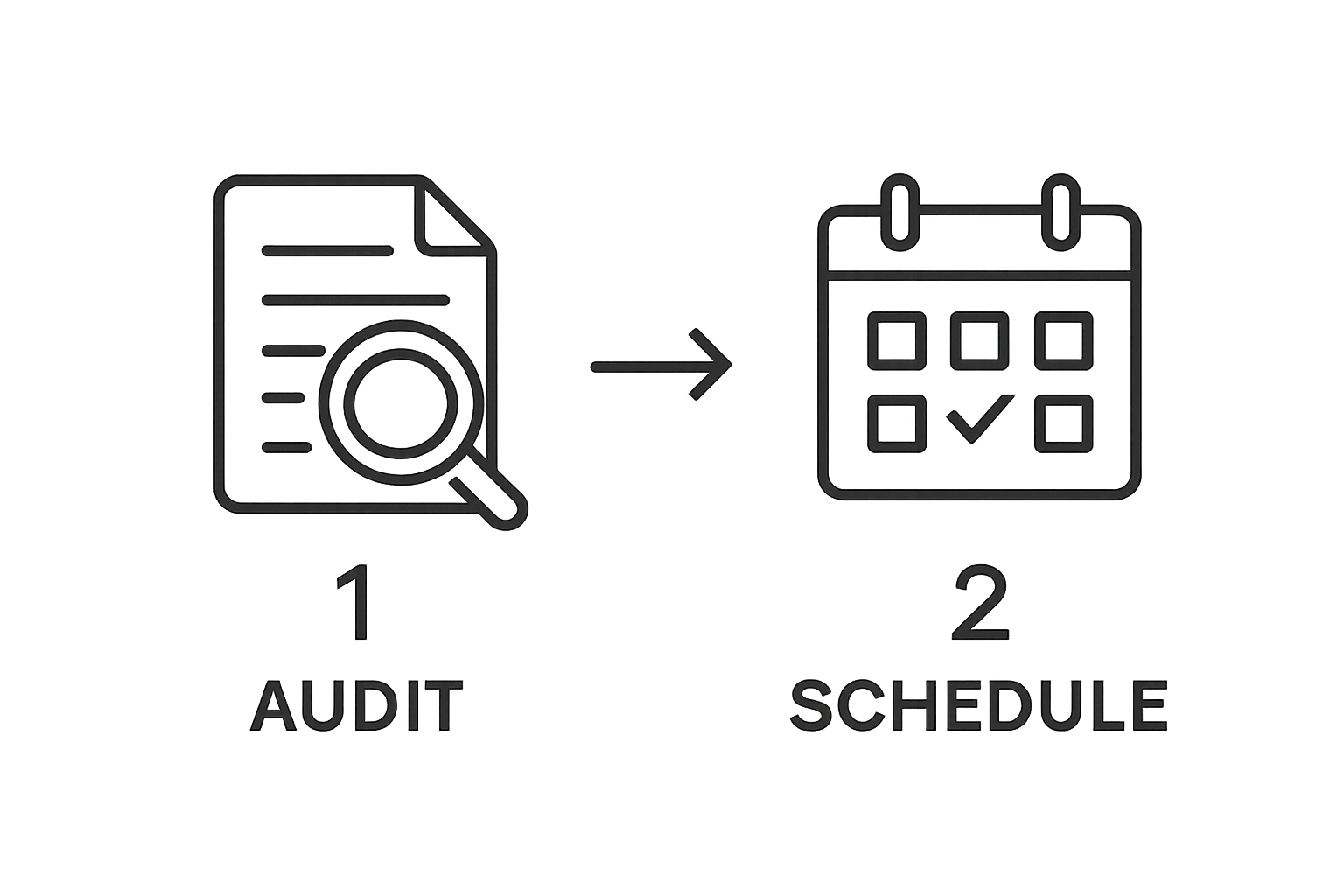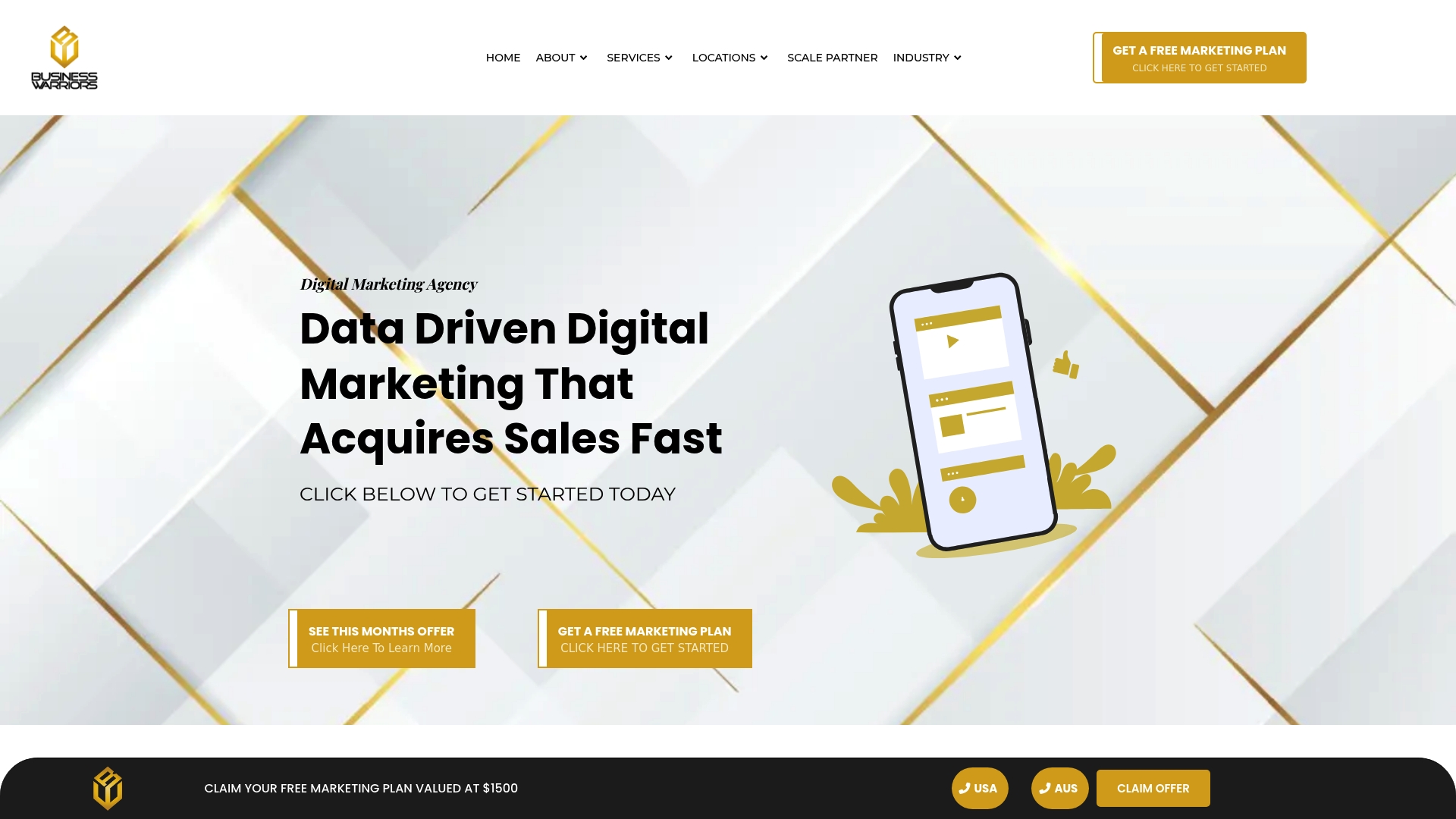
Master Content Calendar Planning for Successful Marketing
Building out a content calendar sounds simple enough until you realise what’s actually involved. You might think it’s just about picking some topics, plugging in dates, and pressing go. But there’s more to it than filling in boxes.
Most businesses skip the first steps, yet understanding your audience’s struggles and setting clear, measurable goals is what shapes every part of your content calendar.
The difference between random posting and actual results comes down to this first move.

Table of Contents
Step 1: Define Your Target Audience and Goals
Step 2: Audit Existing Content and Resources
Step 3: Develop a Theme and Content Topics
Step 4: Schedule and Allocate Content Across Platforms
Step 5: Create a Content Production Workflow
Step 6: Review, Adjust, and Publish Your Calendar
Ready to Turn Content Chaos into Consistent Bookings?
What is the first step in creating a content calendar?
How can I audit my existing content?
What are important considerations when developing themes for content?
How do I schedule and allocate content across different platforms?
Quick Summary
1. Define Target Audience Clearly
Understand demographics, challenges, and preferences to align content. This foundational insight drives the entire content strategy.
2. Conduct a Thorough Content Audit
Review existing content to identify strengths, weaknesses, and gaps. This evaluation informs future content development needs.
3. Establish SMART Marketing Goals
Set specific, measurable, achievable, relevant, and time-bound goals to ensure marketing efforts are focused and effective.
4. Develop Thematic Framework for Content
Create 3-4 audience-aligned themes to guide topics. This cohesive approach unifies your content strategy and enhances audience engagement.
5. Implement Regular Performance Reviews
Conduct monthly or quarterly reviews of content effectiveness. Data-driven insights allow for timely adjustments and improved outcomes.
Step 1: Define Your Target Audience and Goals
Successful content calendar planning begins with crystal clear understanding of who you are targeting and what specific outcomes you want to achieve. This foundational step determines the entire strategic direction of your marketing efforts.
Starting your content calendar journey requires deep audience comprehension. You will need to develop a comprehensive profile that goes beyond basic demographics. Understand their challenges, aspirations, communication preferences, and digital consumption habits. This means conducting thorough market research, analyzing existing customer data, and potentially surveying your current client base.
To create an effective audience profile, gather insights through multiple channels. Examine your current customer interactions, website analytics, social media engagement metrics, and customer feedback. Look for patterns in age ranges, professional backgrounds, spending behaviors, and pain points.Discover more about audience segmentation in our comprehensive target audience guide.
Parallel to audience definition, establish precise marketing goals that are specific, measurable, achievable, relevant, and time-bound (SMART). These goals might include increasing website traffic by 25% in six months, generating 50 qualified leads per quarter, or improving conversion rates by 15%. Each goal should directly connect with your broader business objectives.
Document your findings in a structured format that your entire marketing team can reference. Create a detailed audience persona document and a goals tracking spreadsheet. This documentation becomes your strategic roadmap, ensuring consistent messaging and focused content creation across all marketing channels.
Below is a checklist table to help you verify completion of the key requirements for a robust audience and goals definition phase.

Verify your work by confirming you have:
A detailed audience persona with minimum 5 key characteristics
Clear, quantifiable marketing goals
Documented research supporting your audience insights
Alignment between audience needs and defined marketing objectives
By meticulously completing this initial step, you establish a robust foundation for your content calendar planning that will drive strategic, targeted marketing efforts.
Step 2: Audit Existing Content and Resources
After defining your target audience and goals, the next critical phase in content calendar planning is conducting a comprehensive audit of your existing content and marketing resources. This strategic evaluation helps identify gaps, strengths, and opportunities within your current content ecosystem.
Content auditing is more than simply cataloging existing materials. It involves a systematic review of all content across various platforms, analyzing performance, relevance, and alignment with your recently defined audience personas and marketing objectives. Begin by gathering all content assets from your website, blog, social media channels, email campaigns, and other marketing platforms.
Utilize analytics tools to extract performance metrics for each piece of content. Look beyond surface-level engagement numbers and dig deeper into meaningful indicators like conversion rates, time spent on page, bounce rates, and audience interaction. Learn more about content performance evaluation in our strategic marketing insights.
Classify your existing content into strategic categories: high-performing content that should be repurposed, underperforming content requiring optimization, and content that no longer serves your marketing objectives. Create a detailed spreadsheet tracking each content piece with columns for title, publication date, content type, primary keywords, performance metrics, and recommended actions.
Pay special attention to content gaps where your current materials do not adequately address your target audience’s needs or support your marketing goals. These gaps represent valuable opportunities for future content development. Consider the buyer’s journey stages and ensure you have compelling content for awareness, consideration, and decision phases.
Verify your content audit is complete by confirming you have:
Comprehensive inventory of all existing content assets
Detailed performance analysis spreadsheet
Identified content strengths and weaknesses
Clear list of content gaps and optimization opportunities
Alignment check between current content and defined marketing goals
By methodically auditing your content resources, you create a data-driven foundation for developing a strategic, targeted content calendar that maximizes your marketing effectiveness.

Step 3: Develop a Theme and Content Topics
With your audience defined and content audited, the next pivotal step in content calendar planning is developing compelling themes and content topics that resonate deeply with your target market. This stage transforms your strategic insights into a cohesive narrative framework that guides your entire content strategy.
Thematic planning creates a narrative thread that connects individual content pieces into a meaningful marketing journey. Start by identifying 3-4 overarching themes that align with your audience’s interests, pain points, and your brand’s unique value proposition. These themes should feel like natural extensions of your audience research, addressing their specific challenges and aspirations.
Generate content topics by mapping these themes against different stages of the customer journey. Consider how each topic can provide genuine value, educate, or solve problems for your target audience.Explore advanced content optimization techniques in our comprehensive SEO guideto ensure your topics are both engaging and search-engine friendly.
Brainstorming techniques are crucial in this process. Utilize methods like mind mapping, competitive content analysis, and customer feedback review to uncover unique topic angles. Look for intersections between your brand expertise, audience needs, and emerging industry trends. This approach ensures your content remains relevant, timely, and distinctly valuable.
Consider diversifying your content formats to maintain audience engagement. Mix long-form articles, quick how-to guides, video content, infographics, and interactive resources. Each format should serve a specific purpose within your thematic framework, providing depth and variety to your content ecosystem.
Verify your theme and topic development by confirming you have:
3-4 clear, audience-aligned thematic pillars
Minimum 20-25 specific content topic ideas
Topics mapped across different customer journey stages
Variety of content formats planned
Clear connection between themes and marketing objectives
By meticulously developing themed content topics, you create a strategic roadmap that transforms individual pieces into a powerful, cohesive marketing narrative.
Step 4: Schedule and Allocate Content Across Platforms
Transitioning from topic development to strategic content distribution requires careful platform allocation and precise scheduling. This critical step transforms your content themes into a structured, executable marketing plan that maximizes reach and engagement.
Effective content distribution demands a nuanced understanding of each platform’s unique characteristics and audience behaviors. Select platforms strategically based on where your target audience is most active and receptive. Learn more about optimizing your social media strategy with our comprehensive guide.
Create a comprehensive content matrix that outlines specific content types, publication dates, and platform-specific adaptations. This visual roadmap ensures consistent messaging while allowing flexibility for real-time adjustments. Consider the optimal posting frequencies for each platform: LinkedIn might require weekly long-form content, while Instagram could demand daily visual updates.
Utilize robust content management tools that enable cross-platform scheduling and performance tracking. Platforms like Hootsuite, Buffer, or Sprout Social allow you to plan, schedule, and analyze content distribution seamlessly. These tools provide additional benefits like automated posting, audience engagement metrics, and content performance insights.
Develop platform-specific content variations that respect each channel’s unique communication style. A blog post might become a series of LinkedIn articles, an infographic for Instagram, and bite-sized tips for Twitter. This adaptive approach ensures your core message remains consistent while maximizing engagement across different audience segments.
Verify your content allocation strategy by confirming you have:
Detailed content distribution matrix
Platform-specific content adaptation plan
Scheduled publication dates for each content piece
Selected content management and scheduling tools
Cross-platform messaging consistency
By meticulously scheduling and allocating content, you transform your marketing strategy from a collection of individual pieces into a synchronized, high-impact communication ecosystem.

Step 5: Create a Content Production Workflow
Establishing a robust content production workflow transforms your strategic plans into actionable, consistent marketing materials. This critical step defines clear processes, responsibilities, and quality standards that ensure your content meets both creative and business objectives.
Workflow design requires a systematic approach that balances creativity with operational efficiency. Begin by mapping out each content piece’s journey from initial concept to final publication. Identify specific stages such as research, drafting, editing, design, SEO optimization, and final review.Explore strategic content planning approaches in our comprehensive agency guide.
Implement collaborative project management tools like Asana, Trello, orMonday.comto track content production stages and assign clear responsibilities. These platforms enable real-time collaboration, transparent task tracking, and accountability across team members. Create templates for each content type that standardize formatting, research requirements, and quality checkpoints.
Establish clear roles and responsibilities within your content production ecosystem. This might include dedicated researchers, writers, graphic designers, SEO specialists, and final approvers. Each team member should understand their specific contribution and the expected turnaround times. Consider developing a comprehensive style guide that ensures consistency in tone, brand voice, and technical requirements across all content pieces.
Develop contingency mechanisms to manage potential production bottlenecks. Build buffer times into your workflow, create backup content options, and establish clear communication protocols for addressing delays or quality issues. Regularly review and refine your workflow based on team feedback and content performance metrics.
Verify your content production workflow by confirming you have:
Detailed content production stage map
Assigned roles and responsibilities
Project management tool implementation
Standardized content creation templates
Clear quality control and review processes
Documented communication and escalation protocols
By meticulously crafting a content production workflow, you transform your marketing strategy from a theoretical plan into a reliable, repeatable content generation machine.
This table outlines the key content production workflow stages, responsibilities, and typical tools involved, making it easy to visualise your content creation process.

Step 6: Review, Adjust, and Publish Your Calendar
The final stage of content calendar planning involves continuous evaluation, strategic refinement, and systematic publication. This crucial step transforms your meticulously crafted plan from a static document into a dynamic, responsive marketing tool that evolves with your business objectives and audience needs.
Performance analysis requires a comprehensive and data-driven approach that goes beyond surface-level metrics. Conduct monthly or quarterly deep-dive reviews of your content performance, examining key indicators such as engagement rates, conversion metrics, audience retention, and alignment with original marketing goals.Learn more about adaptive publishing strategies from research insights.
Utilize advanced analytics platforms like Google Analytics, SEMrush, or native platform insights to gather granular performance data. Look for patterns in content types that resonate most with your audience, identifying which themes, formats, and platforms generate the highest engagement and conversions. This analytical approach allows you to make informed, strategic adjustments to your content calendar.
Develop a systematic process for content calendar optimization. Create a feedback loop where performance data directly influences future content planning. This might involve reallocating resources towards high-performing content types, adjusting publication frequencies, or pivoting thematic focus based on audience response. Maintain flexibility while preserving the strategic framework you established in previous planning stages.
Establish a collaborative review process that involves key stakeholders from marketing, sales, and content production teams. Schedule regular sync meetings to discuss performance insights, brainstorm content improvements, and align the content strategy with broader business objectives. Encourage open communication and a culture of continuous improvement.
Verify your content calendar review process by confirming you have:
Comprehensive performance tracking mechanism
Quarterly content strategy review meetings
Data-driven content adjustment protocols
Clear performance benchmarks and goals
Documented insights and strategic modifications
By implementing a rigorous review and adjustment process, you transform your content calendar from a static plan into a dynamic, responsive marketing instrument that consistently delivers value to your audience.
Ready to Turn Content Chaos into Consistent Bookings?
Building a content calendar is only half the battle. You know exactly how overwhelming it is to juggle multiple channels, monitor performance, and actually see marketing goals translate into bookings. Maybe you’re stuck trying to match fresh content to audience needs, or your current system just keeps missing the mark for lead generation and measurable ROI. The article breaks down every step from defining target personas to tracking results, but if you crave a fully integrated approach, you need more than theory – you need a strategic ally.

If your business is ready to experience the Marketing Vortex difference, let’s map your journey from planning to profit. Connect with Business Warriors and discover how our proven systems in SEO and content optimisation, strategic social media management and omnichannel reporting can take your brand further. Do not settle for disconnected campaigns or wasted ad spend when you can have a united, scalable solution. VisitBusiness Warriorsnow to book your strategy call and see how our results-guaranteed process is designed for service-based businesses serious about growth. Your next level starts today.
Frequently Asked Questions
What is the first step in creating a content calendar?
To create a content calendar, the first step is to define your target audience and set clear marketing goals. Understanding your audience’s challenges and aspirations will inform your content strategy.
How can I audit my existing content?
To audit your existing content, compile all materials from various platforms and evaluate their performance against your newly defined audience personas and marketing objectives. This involves analyzing metrics such as engagement rates, conversion rates, and alignment with your goals.
What are important considerations when developing themes for content?
When developing themes for content, choose 3-4 overarching themes that resonate with your audience’s interests. Each theme should address specific challenges and aspirations and tie back to your marketing objectives.
How do I schedule and allocate content across different platforms?
To schedule and allocate content, create a distribution matrix that outlines content types and publication dates specific to each platform. Consider each platform’s audience behaviors and optimize posting frequencies to enhance engagement.




